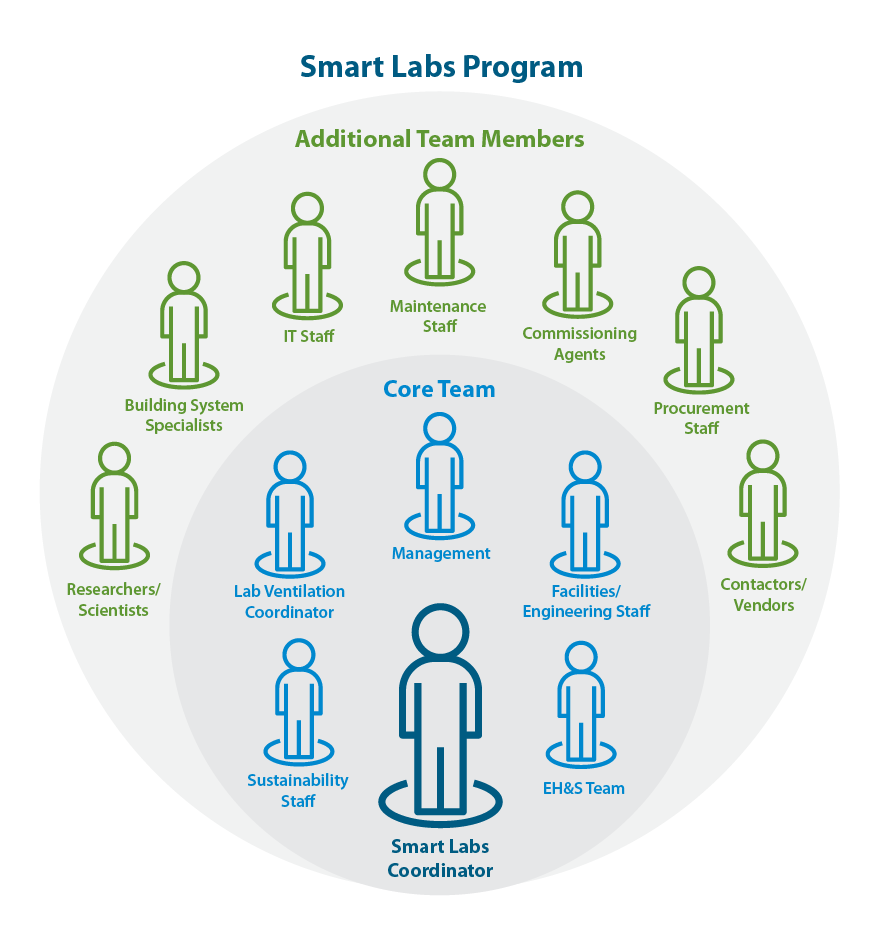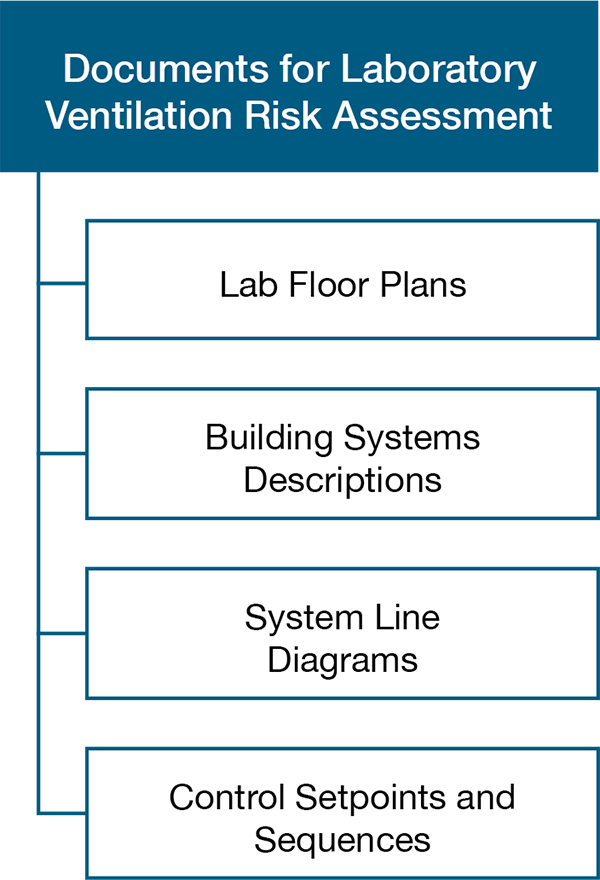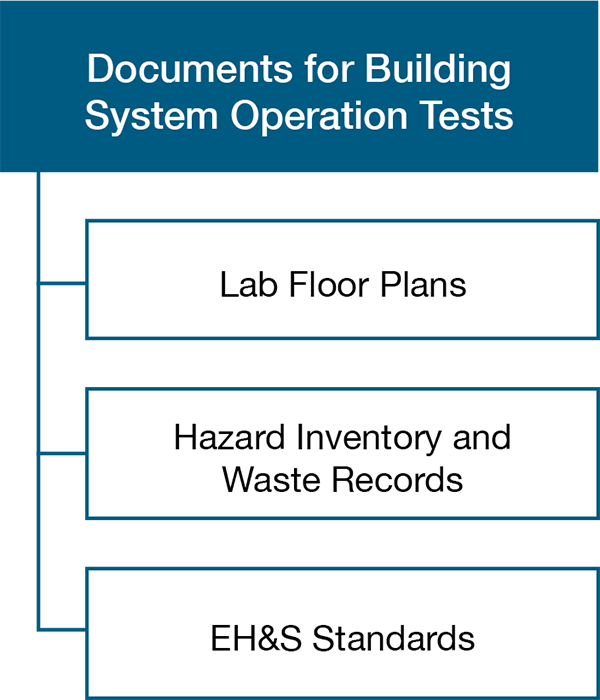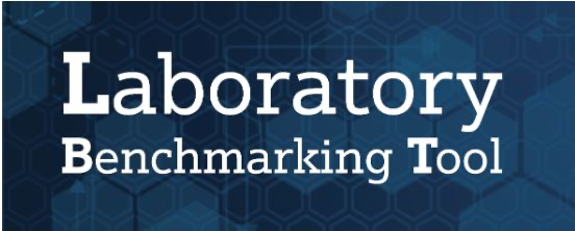Creating a Smart Labs program takes coordination, innovation, and a strong team effort, making planning essential to success. This section provides resources for how to start planning your Smart Labs program. Once a Smart Labs program is established, continue to revisit these planning resources as the program grows, matures, and begins to expand efforts to the entire campus.
Build a Smart Labs Team
Successful projects and programs are achieved through leadership, allocation of sufficient resources, and careful coordination of multiple stakeholders, consultants, contractors, and vendors. Numerous people are involved in the process and their efforts must be integrated to manage the costs of implementation and achieve the expected results.
I give credit to a team working under me, which has in it, very skilled technical people, very imaginative people—people willing to buck the status quo and question all the assumptions that have been touted as best practices for not just years but for decades.
-Wendell Brase, Vice Chancellor, Administrative and Business Services, University of California, Irvine
To build an effective Smart Labs team, it is crucial to leverage expertise, experience, resources, and relationships. Each site will have a different combination of subject matter experts and stakeholders that should be involved in the Smart Labs process.
Engaging Management

As the Smart Labs team is assembled, the management team must be on board to develop an effective program. It is important to involve management early on and identify the representative who can best understand the complexity, safety, and efficiency of laboratories. Having buy-in from our organizations highest level of management ensures that the program will have the necessary support, especially in activities that may cross between various groups or departments.
[3Flow Video 1 for Executive Stakeholders Placeholder]
Smart Labs Coordinator
Many facilities find that having a Smart Labs Coordinator helps to support project execution, manage schedules, liaise between stakeholders, manage information, track progress, and integrate the efforts of consultants, contractors, and vendors involved in the various phases and tasks of the process.
Assign the Smart Labs coordinator or manager to coordinate tasks, schedules, meetings, analysis, and deliverables. The manager or coordinator is responsible for maintaining lines of communication, scheduling tasks, and ensuring program deliverables.
Key Members of a Smart Labs Team
Develop a core team and then engage others as needed. If the facility has existing teams addressing energy, waste, or sustainability, consider leveraging their efforts for the Smart Labs program. In the diagram below, the Smart Labs Coordinator is the main leader of the team. Then the coordinator builds a core team who is mainly involved in activities. Additional team members can be added as needed based on projects and needs.

Kickoff Team Coordination
Facility or sustainability departments often lead an organization’s energy efficiency efforts. Where labs are concerned, safety can never be compromised, so it’s important to ensure the EH&S team is on board from the very start. Their expertise in chemical safety and risk management is crucial to the creation of a safe and effective lab system.
Developing a list of lab stakeholders takes time and knowledge. Ensure it is as inclusive as possible from the beginning to have the best and most up-to-date knowledge of the lab and to create buy-in for any future changes.
Here are some key questions and best practices to consider when building the team:
Level of Effort: The greatest level of effort is required from stakeholders responsible for managing and maintaining operations. These stakeholders are key to successful energy efficiency improvements. Many energy efficiency changes in laboratories require that equipment be operated in a different way.
- Will stakeholders operate the building in a new way?
- How does the team confirm that the building is operating in the improved way?
- What tools, training, or resources can be provided to make the operation more efficient and effective?
Realistic Goals: Developing common objectives and realistic goals will ensure the success of a Smart Labs program. It's important not to move faster than the team is willing to go.
- Should a pilot be completed in an unoccupied lab first?
- What air change rates will the EH&S team support?
- Which buildings will take the least amount of effort to upgrade, but still show energy savings and improved safety?
Also, on an ongoing basis, consider the following questions to ask:
Ongoing Ownership and Management: Laboratories require ongoing mechanical, electrical, and safety management to ensure these complex spaces meet the needs of researchers while keeping them safe in the process.
- Who is involved in ongoing management of the labs?
- Do maintenance and EH&S staff work together?
- Who makes decisions about lab changes?
Ongoing Training Needs: Research changes quickly which means lab spaces and training need to keep up. Ongoing training is an important factor in maintaining safe and efficient laboratories.
- Who has good training resources?
- Is there training the Smart Labs team can do together?
- Can different departments train one another on topics to share resources and talent?
Define Program Goals
Within a team, think about the issues within the labs and understand the goals of the program and/or projects. Consider how science fits into the mission of the organization and how improving laboratories will impact it. The team may create goals to:
- Increase safety
- Increase energy efficiency
- Optimize lab conditions
- Reduce operating costs
- Reduce deferred maintenance.
In developing the goals, the team should keep the following principles in mind:
Safety as the No. 1 Priority: No decision or update should be made if it compromises the safety of the lab's scientists or facilities staff.
Question Everything: Question each proposed change to make sure that it is both ensuring the safety of the facility's occupants and optimizing performance to reduce costs.
Keep the Program Dynamic: A key aspect of the Smart Labs program is that it's smart: it continues to adapt to meet changing needs. This includes all aspects of the program, from dynamic mechanical systems that adapt to provide just the right amount of energy at just the right time to updating management plans to apply current practices.
Develop a Plan
An important step in a successful Smart Labs program is to take the time to prioritize lab buildings based on needs and opportunities. Site management may consider many factors when selecting and prioritizing labs for optimization. A best practice is to start with a lab from the portfolio that requires updating and improvements, where savings can be demonstrated with the least amount of effort compared to other lab buildings. That way, the team can demonstrate the benefits of a Smart Lab before asking for capital for more challenging lab updates and retrofits.
Based on available funds, timing, asset value, and other factors, some buildings should receive higher priority. Following are some steps to take when prioritizing laboratories.
- If the site has started this process and has already completed lab condition status assessments, prioritize the laboratory facilities using the following method:
- Describe the reasoning for prioritized rankings and why the high-priority buildings provide the best opportunity and value. Record keeping of the rationale will help inform future decisions.
- One option is to perform energy and water audits or retrocommissioning to get detailed information about how the lab operates. Learn more about this in the Assess section.
- Information can also be used from operators and facility managers to understand where problems occur in the labs, where changes could be made, and which labs require the most effort to operate.
- Determine what is important to the site. Do labs need the most updated and new equipment? Are the programs in this lab funded for the extended future, or will programs need to change occupants and "flex" the lab spaces? Do greenhouse gas or other emissions goals require a reduction in energy use across the campus and in labs?
- Gather a list of labs' known issues, upcoming projects, and maintenance trends and requests.
- Prioritization can take many forms so use what works for the site. Ensuring the team has buy-in to choices is the most important piece of this process.
- Prioritization can be a very simple process to start. Here's an example of a template to help start prioritizing the labs:
- Ensure an update to this list regularly as lab upgrades and projects are finished. This can help track the performance and also make adjustments as the Smart Labs program build.
- The operational status and condition of each building system weighs heavily in determining the complexity, cost and duration of an optimization project.
Gather Building Documents
To begin the prioritization process, the team will need to develop documentation for the program and to support the assessment phase.
Develop a Resource Usage Baseline


Conduct an analysis of energy and operating costs to establish current conditions, identify major consumers, and evaluate patterns in use. These efforts can then help predict theoretical energy savings for benefit and payback analysis.
A resource usage baseline is the building/campus set of data and metrics that describes the current status of energy, airflow, water, and other consumers.
Having a baseline for labs as well as overall Smart Labs program will help determine the effectiveness and success. A baseline can also help determine what facilities need more attention and ensure the measures, projects and upgrades have the results anticipated. Having a way to determine the success and lessons learned of the Smart Labs pilot buildings and overall program can ensure the team receives funding and resources for future projects and continuous improvement.
It is essential to develop a baseline using key performance metrics for labs. For energy metrics, it is recommended to include:
- Total energy consumption or energy intensity
- Average cubic feet per minute (CFM) per square foot in lab areas.
For water metrics, it is recommended that total water consumption or water intensity be included.
Additional metrics can support other site goals or opportunities around carbon reduction, greenhouse gas reduction, water reduction, or others. The table below contains a variety of energy metrics to consider for labs.
| Standard Set of Laboratory Energy Use, Efficiency, and Cost MetricsA | |||
|---|---|---|---|
| System | Energy Use Metrics | System/Load Efficiency Metrics | Cost Metrics |
| Whole Building | kWh/ft2-yr (electric)B kBTU/ft2-yr (site) kBTU/ft2-yr (source) |
Peak W/ft2 | Utility $/ft2-yr |
| Ventilation | kwh/ft2-yr | Peak kW/ft2 Peak CFM/ft2 (lab) Avg CFM/ft2 (lab) Avg CFM/peak CFM $/kWh |
$/kW peak $/CFM/yr |
| Cooling | kWh/ft2-yr | Peak kW/ft2 Peak ton/ft2 |
$/kWh $/kW peak |
| Heating | kBTU/ft2-yr | $/kBTU | |
| Lighting | kWh/ft2-yr | Peak W/ft2 | $/kWh |
| Process Equipment | kWh/ft2-yr | Peak W/ft2 | $/kWh |
| Water | gal/ft2-yr | Peak gal/ft2 | $/gal/yr |
|
A Adapted from Rating energy efficiency and sustainability in laboratories: results and lessons from the Labs21 program. Mathew P, Sartor D, Van Geet O, Reilly S. 2003. Proceedings of the ACEEE 2003 Summer Study on Energy Efficiency in Buildings, vol. 4, 321–329. B May apply to other fuel sources |
|||
Building Information for Prioritizing Projects
The Smart Labs team can use a basic table like the information below to collect data to prioritize buildings and labs to start the next phase, Assess.
| Building Name | Lab #1 | Lab #2 | Lab #3 |
|---|---|---|---|
| Year Built | |||
| Building Area (ft2) | |||
| Total Lab Area (ft2) | |||
| # of Labs | |||
| Lab Type(s) | |||
| # of Occupants | |||
| Occupancy Hours | |||
| HVAC System Type(s) | |||
| Lighting System Type(s) | |||
| Fuel Type(s) | |||
| Analytic(s) | |||
| Other |
| Priority | Building | Key Performance Indicators |
|---|---|---|
| High (next one to two years) | ||
| Medium (next two to five years) | ||
| Low (more than five years out) |
Laboratory Benchmarking Tool

Photo credit: Laboratory Benchmarking Tool (LBNL/I2SL)
The International Institute for Sustainable Laboratories (I2SL) hosts the Laboratory Benchmarking Tool. Providing access to data from hundreds of lab facilities, the Laboratory Benchmarking Tool is designed to be used by a wide range of professionals including lab owners, operators, facility managers, and design engineers. Lab energy data from industry, academia, government, healthcare, and more are included in the tool. The tool can be used to:
- Prioritize energy-saving projects within a portfolio of buildings using insight into building energy consumption
- Pursue LEED for Operations and Maintenance certification, conduct AIA 2030 reporting, and complete ASHRAE audits
- Compare the lab's energy use intensity to that of peer facilities with similar functional requirements, climate zones, or heating and cooling systems
- Access energy and facility data for more than 750 lab buildings.
Learn how to use the Laboratory Benchmarking Tool.
Campus Planning
Where multiple buildings are involved, planning involves a qualitative scoping study to collect pertinent data for profiling the buildings. It is recommended that the initial study be limited to less than 10 buildings with the goal of selecting 5 or fewer buildings for the next phase of assessment. By reviewing opportunities, estimating costs and describing benefits, opportunities can be prioritized and the best candidates for optimization selected.
Plan for an Information Layer
As the team collects all this information, organized information and analytics are essential for safer, high-performance laboratories. The information network within the buildings and/or campus can assist the team in gathering information to assess the status of the laboratories. Key objectives of an information layer include:
- Understanding the current building automation system (BAS) and developing a future BAS plan
- Developing a process for fault detection and diagnostics (current and planned)
- Understanding plans for analytics, control rooms, dashboards, and integration with other systems
- Use of the information layer to inform future project decisions.
Deliverable: Smart Labs Roadmap
Often a team finds it helpful to draft a guiding document on the progress made in the plan step to record information for management and other stakeholders. Based on the progress made in the planning process, the Smart Labs team has the information to develop a guiding document for the next steps. Typical sections include:
- Team formation
- Laboratory building inventory
- Lab condition assessment
- Prioritization of labs
- Timeline and plan for building assessments
- Management plan
- Planning for an information layer.
Develop a Smart Labs Roadmap for your organization today with this Planning template!